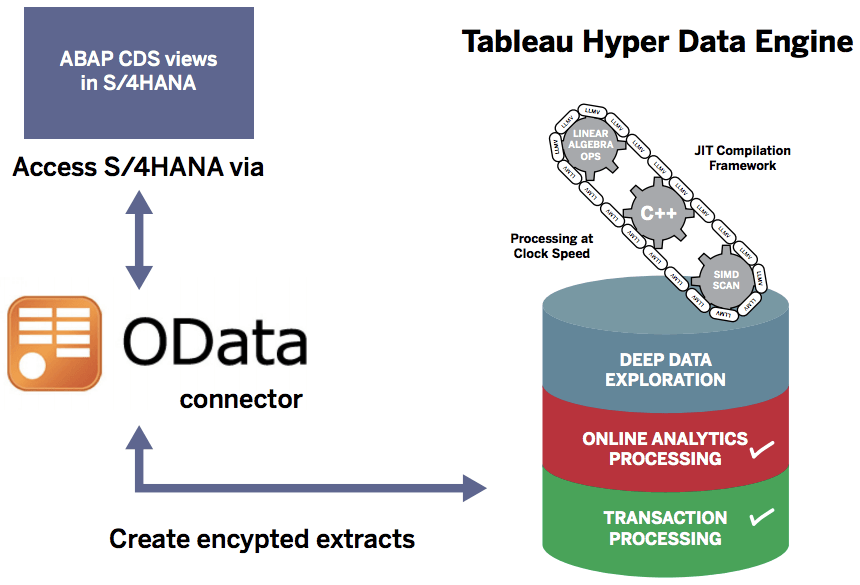Continuing our enterprise investments with SAP Certification
Tableau is now SAP-Certified to integrate with SAP HANA
We are happy to announce Tableau has achieved official SAP Certification (HANA-BI-SQL 2.0) for integration with SAP HANA for Tableau Desktop, Server, Online, and Tableau Prep. The process to become certified is comprehensive and requires a lot of collaboration. The Tableau and SAP product and engineering teams worked carefully to best understand how our products work together to support our shared customers.
Tableau’s commitment to SAP has been significant, helping our customers enjoy the combination of Tableau and SAP HANA to quickly analyze their data. Tableau first introduced support for SAP HANA in our Tableau 7.09 release nearly eight years ago. Since then, we’ve made numerous improvements to the connector based on your feedback, including:
- SAP HANA leveled hierarchies support introduced in Tableau 2019.4
- The ability to connect Tableau Prep directly to SAP HANA, one of the most popular requests from the Tableau Community
- An updated OData connector that supports extracting data directly from S/4HANA ABAP CDS Views, shipped in the Tableau 2020.2 release
- Enhancements to our SAP HANA connector, giving users the ability to connect to Table Functions (stored procedures that return a table), coming soon with Tableau 2020.3
And as our new certification shows, we remain committed to our enterprise users who rely on Tableau to access and get the most out of their SAP HANA environments.

How does our Certification help you?
It’s critically important to us that our customers can access all of their data easily and confidently, with robust, smooth integrations with industry-leading solutions. For joint Tableau and SAP customers, this offers several benefits:
- Confidence that our pre-tested integrations are working as fast and efficiently as possible
- Minimizing interruptions and costs when implementing and upgrading solutions
- Access to more integrated services and support from SAP
- Compliance and peace of mind for customers with SAP Runtime licensing
Preparing for those migrating to S/4HANA
S/4HANA is SAP's next-generation, intelligent ERP business suite designed specifically for SAP HANA. With SAP’s announcement to end mainstream maintenance for its Business Suite at the end of 2027, many users are already migrating to S/4HANA. We want our customers on SAP to know that we are being proactive in taking steps to ensure our integration is up to date. Like any migration process, it is important to start planning and implementing early on—and that is exactly what we are doing to support our customers with this SAP Certification.
In regards to S/4HANA, there are best practices and considerations that need to be understood when integrating with Tableau. An important feature of S/4HANA is its ability to support transactions and analytics in the same database. However, the capability of supporting both analytics and transactions comes with a cost—SAP recommends that embedded analytics should only be leveraged to support fact-driven process handling and embedded decision support inside of transactions. In other words, doing analytical processing directly in S/4HANA should only be done in support of transactional workflows.
In order to best prepare and educate you on how to optimize Tableau and S/4HANA for analytics, we have recently published a new whitepaper, discussing:
- Integrating BW/4HANA enterprise data warehouse with S/4HANA and using Tableau's HANA connector to consume SAP HANA's Calculation Views
- Replicating data into a separate HANA database to address targeted operational reporting requirements
- Creating Tableau Hyper extracts for analyzing operational data from SAP (as shown in the image below)
- Leveraging a third-party database system, like Snowflake, Amazon Redshift, Google BigQuery, or another
- Additional considerations—including licensing

Customers can connect to S/4HANA ABAP CDS Views via the OData connector to create a Tableau Hyper Extract, taking advantage of fast performance for extract creation and query execution.
To learn more, check out our Tableau and S/4HANA Analytics whitepaper today!
Historias relacionadas
Suscribirse a nuestro blog
Obtenga las últimas actualizaciones de Tableau en su bandeja de entrada.








